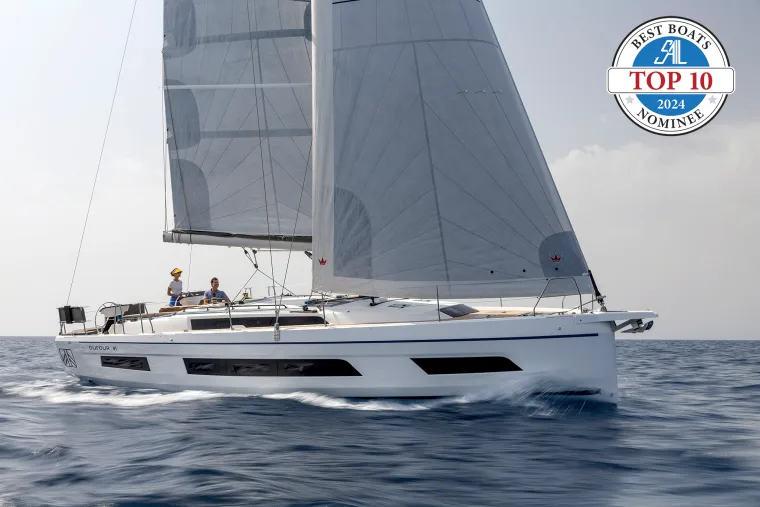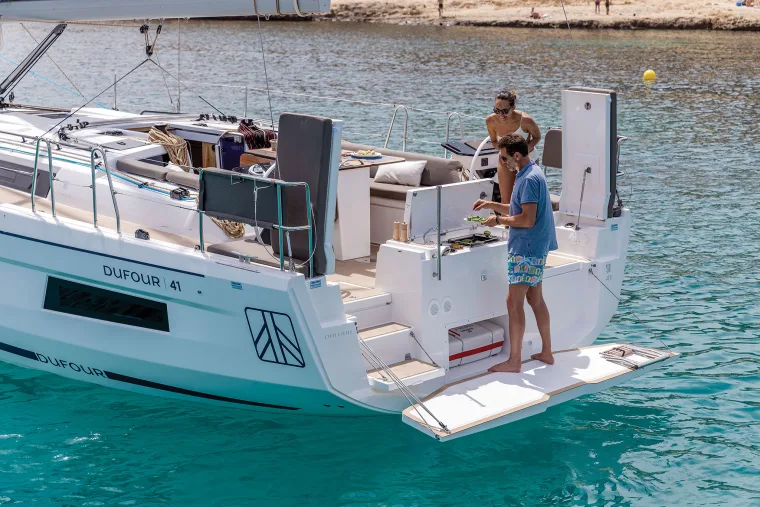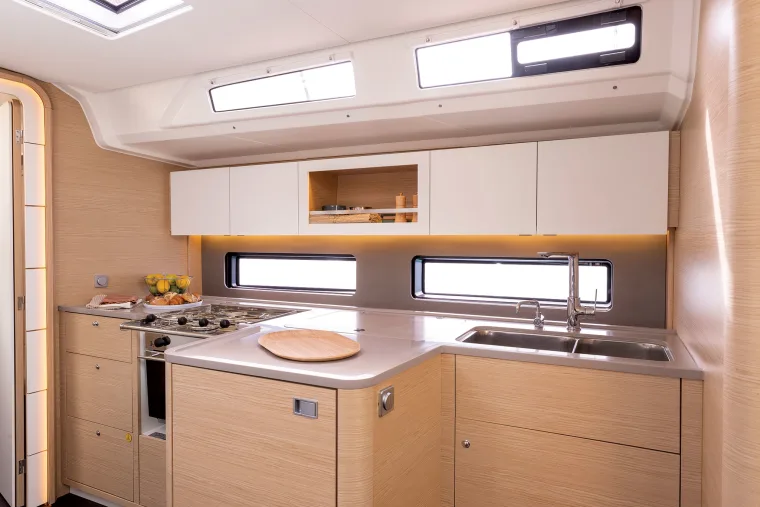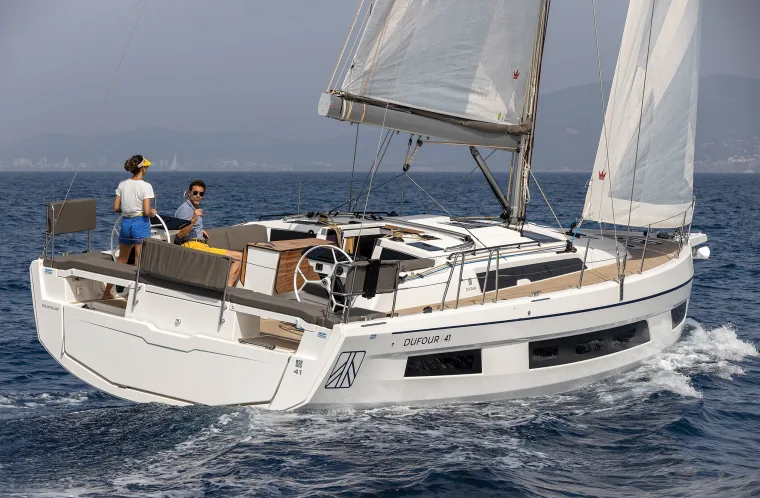By Wendy Mitman Clarke, Sail magazine
Fun, fast, and comfortable: A romp in Mallorca reveals the new Dufour 41 as playful yet practical.

You can take the sailor out of racing, but you can’t take racing out of the sailor. So, when Nicolas Berenger, product and commercial director of Dufour Yachts, tells me that we might have to tuck in a reef as we head out for the afternoon on the new Dufour 41 on the Bahia de Palma in Mallorca, I’m not holding my breath.
Berenger’s résumé includes seven Figaros and multiple French national championship titles. And all morning, as we enjoyed a shifty breeze around 12-14 knots, I had watched how he kept asking hull No. 1 of Dufour’s new model to do little more. Making 7.6 knots of boat speed in 13 knots of wind with the full main and the 108% genoa, he looked at the true wind angle (TWA) of 64 degrees and politely took the helm to push her up to more like 50 TWA, where we maintained 6.3 knots with little effort in the sparkling, flat water. Another 5 degrees up and we were still making good 6 knots, and as the breeze puffed up another knot, we lifted up to 41 holding on to 6 knots.
He seemed satisfied, and even more so when we bore off, set the bright gold Elvstrøm asymmetrical chute, and rocketed at 9 knots in 12 knots of breeze back to La Lonja Marina for lunch.
But now it’s afternoon, a spirited sea breeze touching 20 has filled in, and I’m thinking about what Berenger had said earlier, that in 18 knots true, it might be time to reef-if he were cruising. He mentions it again after we extract ourselves from the dock where the breeze had us pinned (a bow thruster is optional, and I’d get one) and motor into the wind leaving the harbor-7.3 knots at 2,400 rpm on the 50-hp Volvo with a folding three-blade prop on a saildrive. But in the end-no surprise-it’s the full main that goes up on the deck-stepped, 56-foot Z Spars aluminum mast, and we charge off into what is now a short chop with some whitecaps.
A few things stand out. Despite the boat’s beam that’s carried well forward for maximum volume and a very full bow, she marshals this chop quite well with less slamming than I’d expect, and while waves douse the foredeck now and then, we are perfectly dry in the voluminous cockpit. It’s worth noting that this boat has 16% higher freeboard than its comparable older sibling launched in 2016, the 412.
The boat gets to a certain angle of heel-18 degrees per Felci Yachts Design parameters-and wants to stay there for best speed; in one gust, we depower the main a bit and the boat accelerates as she comes up slightly to that sweet spot. There’s no doubt we’re a skosh overpowered in the puffs, and it’s not fingertip sailing, but I still feel in good control at the helm, especially knowing we could downshift a gear with a reef and be flatter and even faster.
It’s lively, invigorating sailing, and we joke about how we’re giving the J Class thoroughbreds racing in the Superyacht Cup Palma a run for it, even as one swoops down on us like an avenging angel. It reminds me that even if cruising-not racing-is the goal, fun, fast, comfortable sailing is the best way to get there. Dufour has achieved this and more with this easily handled 41.
‘œWe want people to really sail, and we want to invest in that and be sure that the boats are really sailing, and not with an engine,’ Berenger says. ‘œWe worked with Elvstrøm to make the sails deeper than usual’¦We try to push the limit everywhere, not like a racing boat, but we try to make it better.’
This new 41 comes quickly on the heels of the Dufour 37, one of SAIL‘s Top 10 Best Boats of 2023. Both draw their DNA from their bigger sister the 470 launched two years ago, with the same sheer line and chine that enables the boat to carry maximum volume forward on a narrower profile under the waterline.
‘œWe had a long, tough discussion between [naval architect] Umberto Felci and Lucas Ardizio, the interior designer of the boat, and our team to get more millimeters of width, because Umberto wants a narrow boat and a boat which sails very well upwind, and we want more volume, more comfortable space,’ Berenger says. ‘œSo it was always a long discussion-a lot of back and forth.’
Like the 470, the 41 comes in three versions-Easy, Ocean, and Performance. Easy has a self-tacking jib and two winches at the companionway to handle halyards and mainsheet. Ocean-the version we are sailing, which is by far the most popular, Berenger says-features an overlapping genoa controlled through a pair of coachhouse tracks and led aft through organizers to an additional two winches on the coaming in front of each helm. This version also has a Code 0 and an asymmetrical spinnaker flown off the 2-foot 3-inch integral bowsprit.

Performance version offers a boom that’s about 2 feet longer, adding 10% more area to the mainsail, and sheeting led to a padeye in the cockpit just aft of the table. All are German-sheeted mainsails without a traveler.
One big change for this boat was moving the mast aft, which enabled several things-a bigger foretriangle and hence bigger, more powerful headsails and about 17 square feet more sail area overall, and belowdecks, a bigger master cabin forward with the main bulkhead moved aft.
Another big change is in the cockpit, which to some extent is the star of this show in accord with Dufour’s emphasis on outdoor living. The companionway has been moved forward so that the boat has the same cockpit length as the 430 (it also shares the same 14-foot beam as the 430), creating an awesome lounging, living, and entertaining space for a 41-footer. I had no problem stretching completely on the cockpit seats (providing a rough measurement just shy of 6 feet), envisioning sleeping under the Spanish stars.
A drop-leaf centerline table with an integrated handhold provides a sturdy foot brace when heeling, a handy covered storage area in the center for stuff like phones, hats, tablets, and sunscreen, and even a solid place to stand to access the aft end of the boom and mainsail if needed. Immediately behind it in the cockpit floor is the deck plate for an emergency tiller.
Dual helms, controlling a single 5-foot 3-inch rudder, are on angled Jefa pedestals. Each has a B&G multifunction display and an integrated handhold inboard. Engine controls are to starboard, with the throttle at calf level. Visibility all around is unimpeded even for vertically challenged sailors. My only gripe is a lack of a lifting step or foot brace when steering at a heel.
Between the helms is a centerline seat. Hinged forward, it opens to the popular outdoor galley with small sink and plancha grill facing aft. You can cook while standing on the drop-down transom platform, which is easily raised and lowered with a simple block and jam-cleat system. In front of it beneath the cockpit floor is a life raft with immediate access to the platform, and an integral swim ladder folds out. Later in the afternoon, when we drop the hook in a nearby cala for a swim, the outdoor shower here also comes in quite handy.
A gas bottle locker is beneath the floor under the starboard helm, while a hatch under the port helm provides access to a lazarette storage area as well as the rudder quadrant and associated cabling and gear. One note: There’s no obvious place to easily store a dinghy. Berenger says they tried removable davits but ‘œthey weren’t good enough.’ Owners may want to sort an arrangement by adding an arch or davits off the back of a bimini.
As commodious as this cockpit is, what impresses me most are the practical details that translate into good ergonomics and sensible sail handling. Handholds are always where I expect. Lines on either side of the companionway and atop the coaming lead neatly through organizers and jammers to the winches; the only note here is that this coaming is quite wide, making it a healthy step over and onto the seat to move in and out of the cockpit. Less agile sailors might find it a little awkward, though you can always go around aft of the helms. Trimming at the aft primaries is from the cockpit or the side deck, although they’re quite close to the helms, so flying elbows might make contact-or you can engage the electric option. Despite the table’s size, four of us move around comfortably on all points of sail, never crowding one another.
The same is true of the wide, uncluttered side decks-10 to 30% wider than on the 412-bordered by a solid 2-inch bulwark. A solid handhold is on either side of the cabinhouse, and it’s easy to move past the shrouds attached outboard. The foredeck, made for a sunpad and fully a third longer than the 412, is likewise clear, with three flush-mounted hatches.
A Lewmar windlass sits behind the furler, with the rode going directly into a chain locker below. Anchor locker access is via the forward berth below-a downside for those who’d prefer deck access.
Belowdecks on the 41 is also a bright and surprisingly large space, what designer Lucas Ardizio terms the boat’s ‘œfourth dimension.’ Our test boat was one of three layouts, with two aft cabins, two heads in the main cabin, and the owner’s cabin forward with en-suite head. Three heads for 41 feet seems like overkill, and in fact one of the salon heads can be converted to a storage, shower, and wet locker space.

While some aft cabins fall into the cave category, these are anything but, with a hatch overhead, a small portlight opening into the cockpit, rivers of light flowing in through the long side windows, and an additional window above just inside the entrance. The owners’ cabin forward is incredibly spacious, also bright and well ventilated. It’s so big that in one of the layouts (likely for the charter market because why else would you do this?) this space is split in half, offering two forward cabins with full beds for a four-cabin layout.
The salon features a linear galley to starboard with twin stainless steel sinks and a two-burner gas stove flanking the fridge, front and top accessed. An extra small freezer can be added just forward of the stove. Offshore purists will argue with the safety of this lateral design, but there’s no denying how easy it is for two people to work here without any crowding (and you probably could attach a safety strap from the fridge corner to the countertop in a pinch).
Opposite is the C-shaped dinette, which can include a hi-lo table for yet more bunkage. There’s no nav station, so the control panel, VHF radio, and other items you’d expect in a nav station are in a shelf behind the dinette settee. I know it’s old school to want a nav station in these days of WiFi-connected everything, but I’d happily forego a third head for a dedicated space for all things boat management- and navigation-related.
As with the deck and cockpit, there’s a pragmatism and simplicity that underlies the boat’s mechanicals, supporting access and maintenance. Engine access is beneath the lifting steps and via panels in either cabin, with the 115-amp Volvo alternator front and center. Batteries are 300 aH standard AGMs, easily reached behind a panel in the port aft cabin; the 3,000-watt Victron inverter is just aft of this, also behind a panel.
Wiring and plumbing runs are separated and neatly protected in plywood channels just beneath the floorboards well clear of the bilge. Manual and automatic bilge pumps are fully accessible under the cabin sole, and through hulls are similarly handy to reach. Fastmount connectors hold the overhead panels allowing for easy removal if needed. Everything points to careful thought, execution, and attention to detail.
Construction is infused polyester and fiberglass, with the goal of a lighter, stiffer boat. A first gelcoat layer is impregnated with vinylester resin for an optimum barrier coat. Structural framing is laminated to the hull, and decks are sandwich construction with injected core.
In truth, these details grow distant as we sway at anchor in Cala Comtesa, where the beach umbrellas resemble a spillage of Skittles and the crowded waters bustle like a carnival. After a brief swim, the anchor is up, and in minutes, we’re in the clear. The angle back to the harbor is perfect for a rocking ride under the A-sail, and we’re off.

LOA 41’8’
LWL 36’6’
Beam 14’1’
Draft 6’8’
Ballast 5,732 lb
Displacement (light) 21,384 lbs
Sail Area 898 sq ft (main and genoa), 420 sq ft (A-sail), 262 sq ft (Code 0)
Engine 50hp (optional 60hp)
Designer Felci Yachts Design
Builder Dufour Yachts dufour-yachts.com
This review first appeared in Sail Magazine on 12 July 2023.
